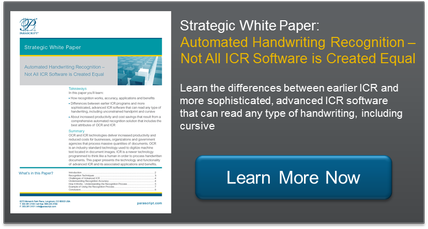Even with iPhones, iPads, and other digital devices, forms, applications, checks and documents are still widely used to collect data. While obtaining and leveraging this information from forms is a critical business differentiator, getting the data from documents continues to be a challenge, for many organizations, even in our digital age.
OCR (or Optical Character Recognition) and ICR (or Intelligent Character Recognition) technologies offer the potential to harness this information, provide increased productivity, time-savings and reduced costs for businesses, financial institutions and government agencies that process massive quantities of documents.
While OCR is an industry standard used to digitize machine text located in document images, ICR is a newer technology programmed to think like a human in order to extract handwritten information. ICR increases productivity, reduces risk, improves ROI, and lowers operational costs.
But not all ICR software is created equal, some offer more sophisticated functionality than others. These more advanced ICR technologies can perform automated recognition on unconstrained handprint and cursive handwriting, as well as difficult machine print that may be encountered on forms. In order to recognize unconstrained text and cursive writing, advanced ICR technologies must evaluate data based on its context, versus looking solely at individual characters. Advanced ICR technologies take a holistic approach to recognition that combines highly sophisticated mathematical algorithms, neural network applications, image interpretation using a special description language, and content validation within context that happens during the recognition process.
When compared to character-dependent recognition systems, advanced ICR offers significant cost savings and greater recognition versatility. Advanced ICR also delivers high read rates and accuracy levels.
Recent handwriting recognition technology advancements expand ICR functionality and give corporations that need to process large volumes of data a reason to take a closer look. When compared to manual data entry and early-generation, character-dependent recognition systems, advanced ICR can offer significant cost savings, greater recognition versatility and the ability to adapt to any style of form, along with high read rates and accuracy levels.
For more differences in OCR and ICR technologies, download our white paper: Automated Handwriting Recognition Not All ICR Software is Created Equal.

